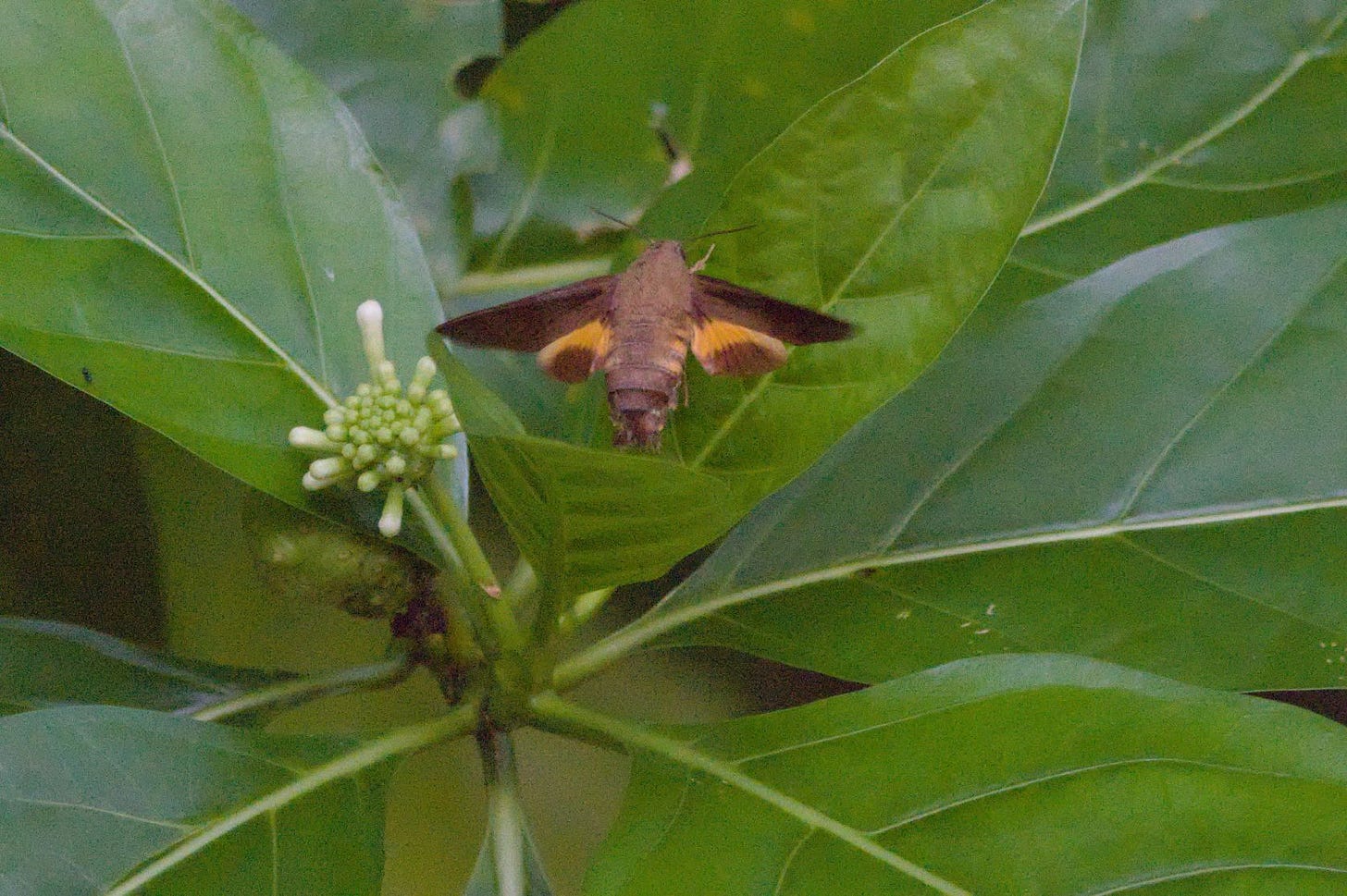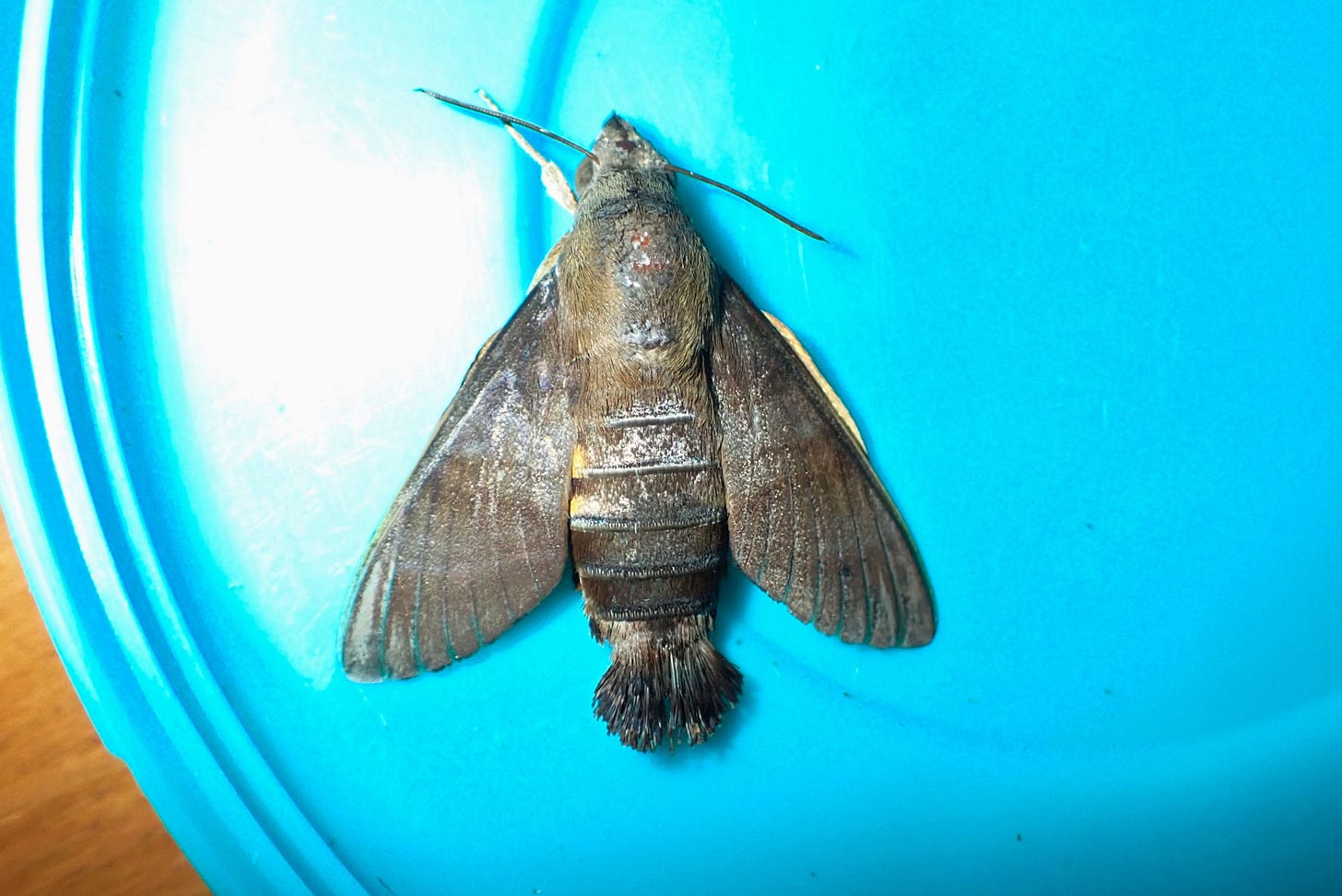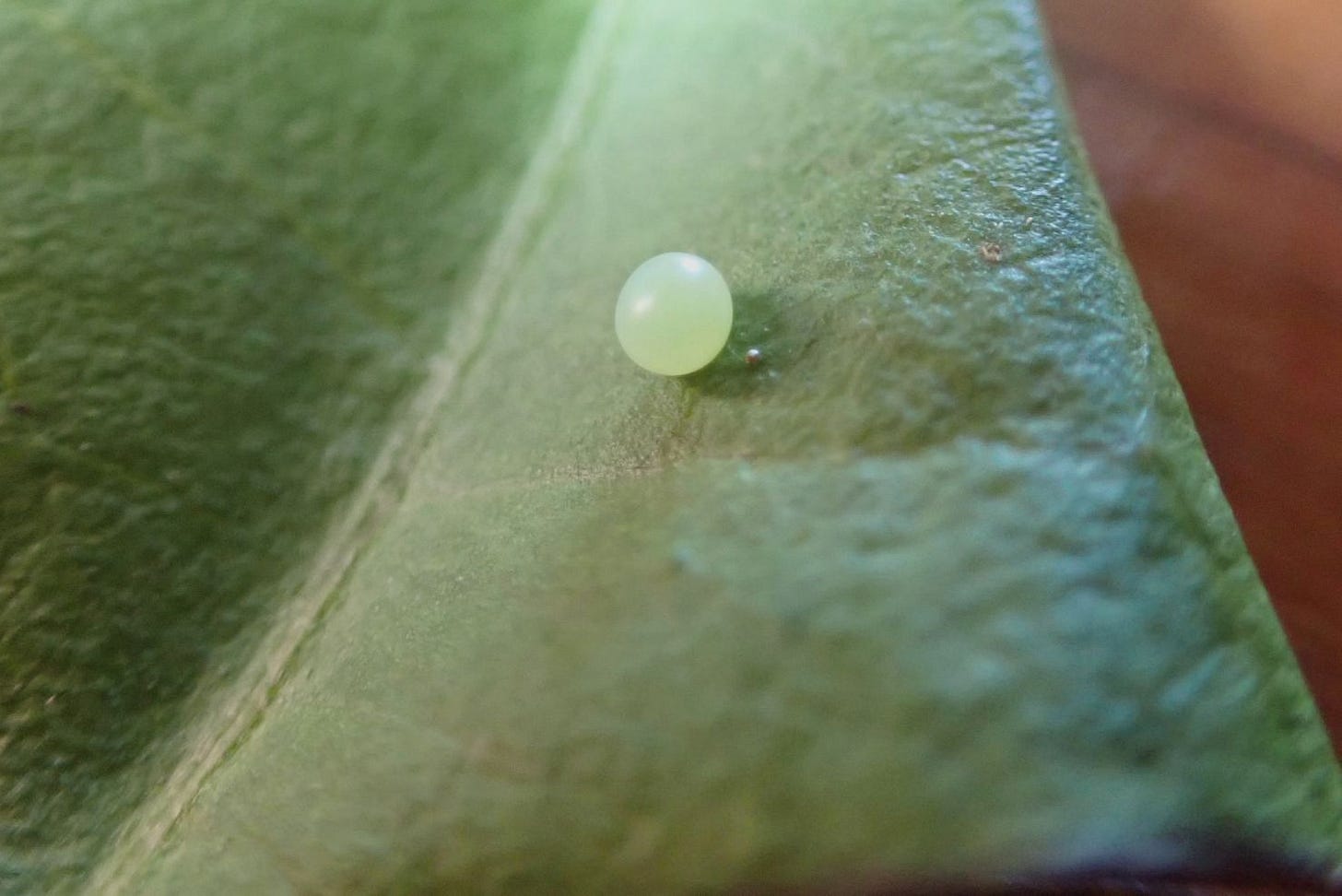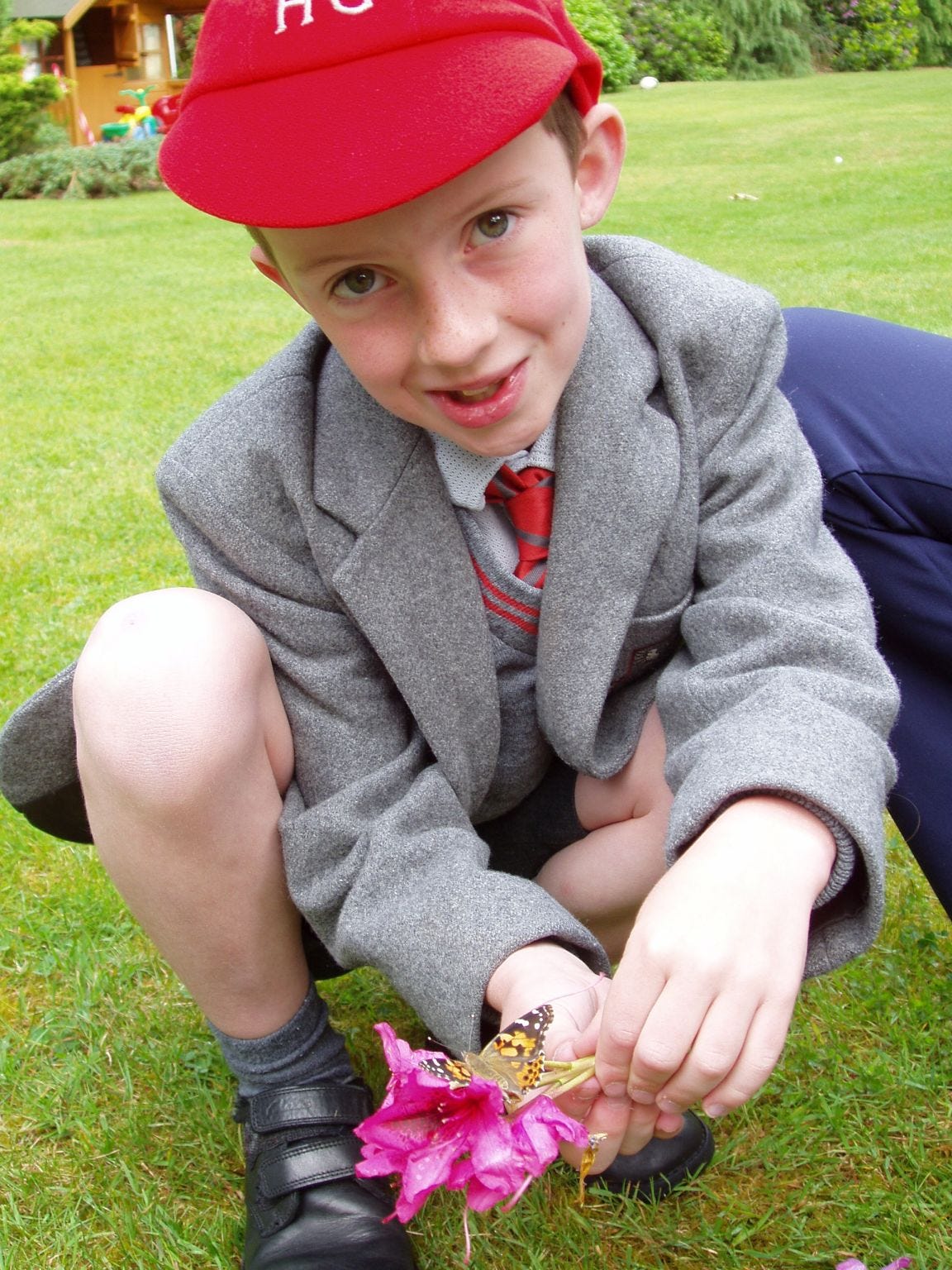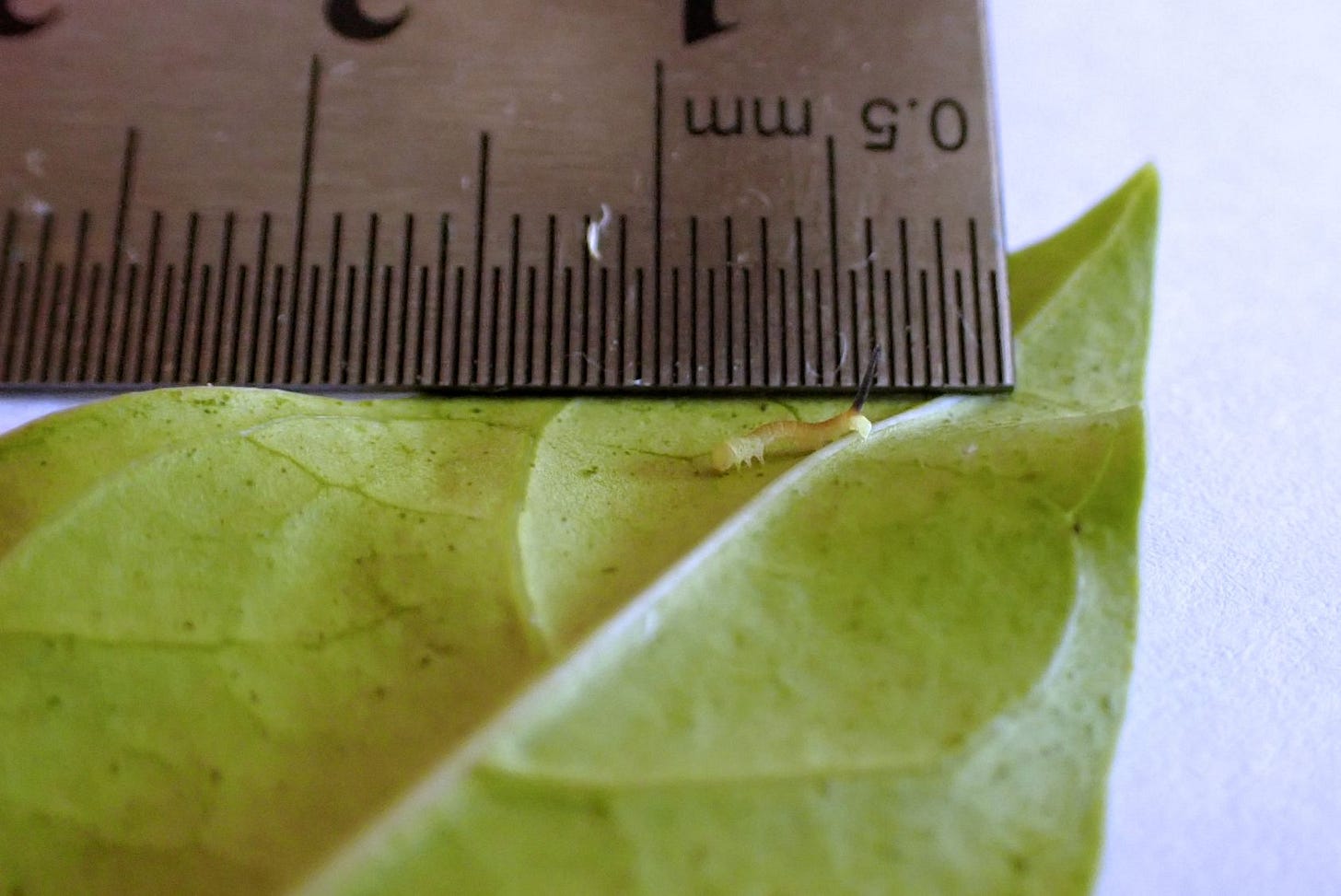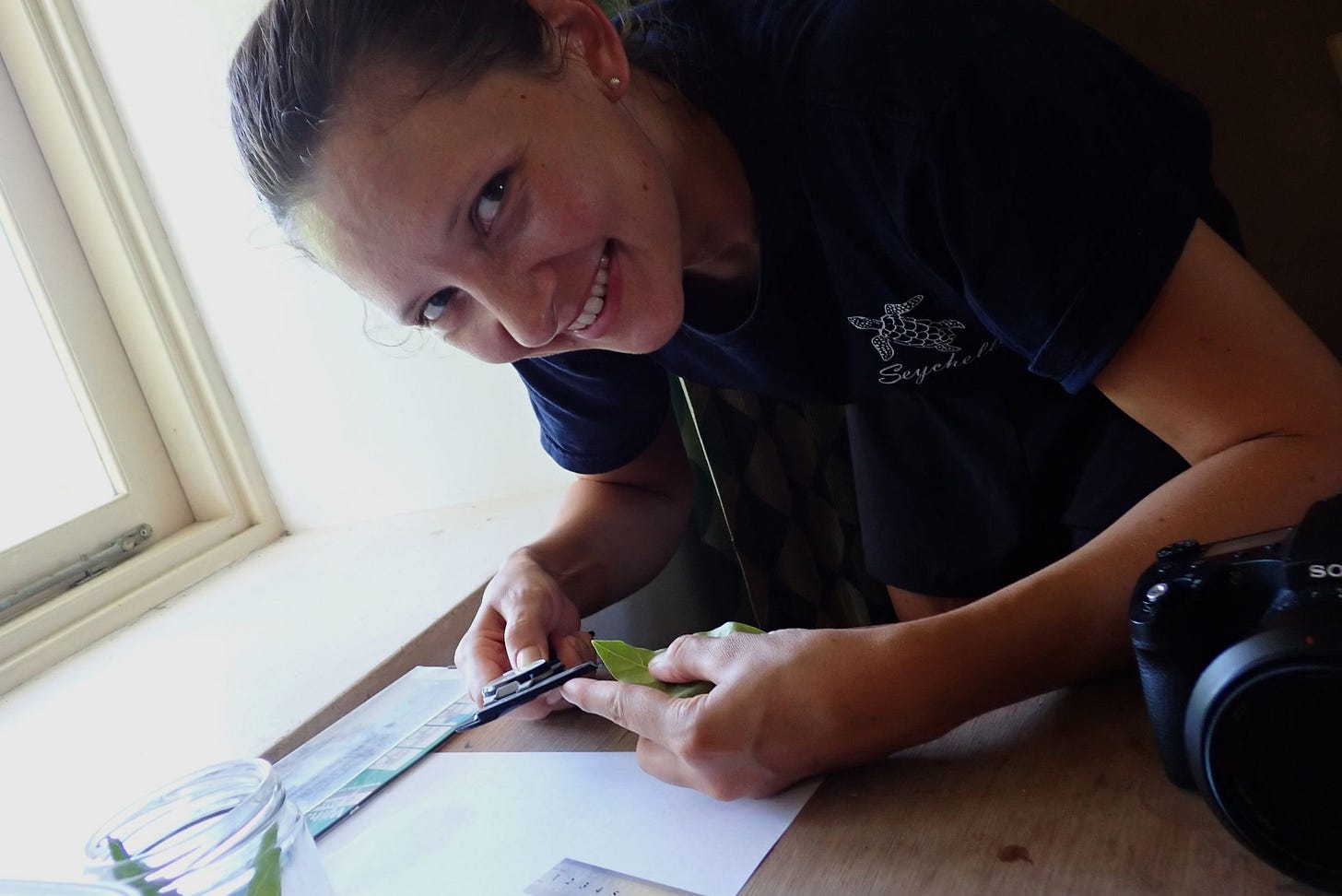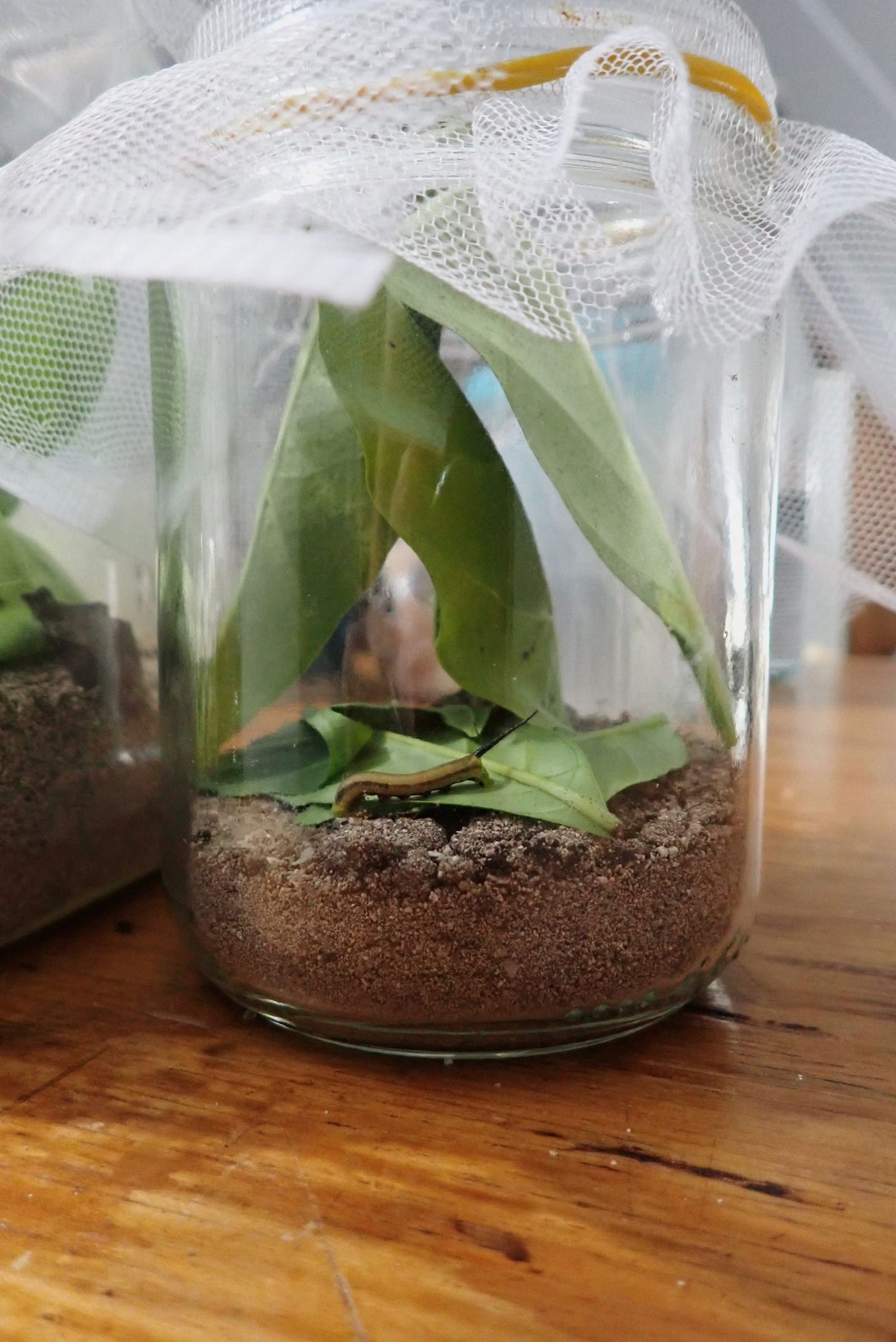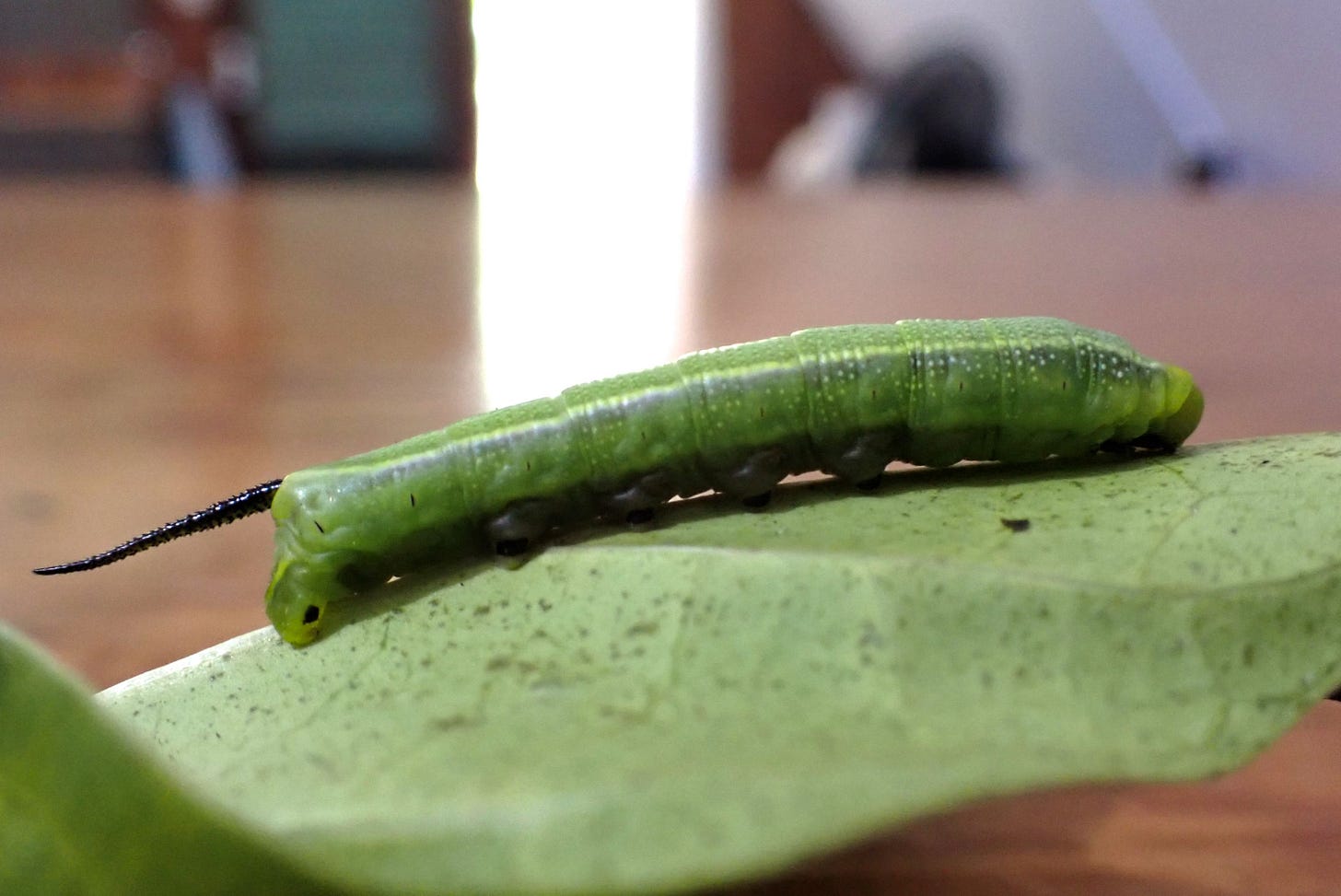Deutsche Version siehe unten
When people ask us what we do here, our default line is that we are responsible for everything that lives on the island, apart from the people. That could include turtles, tortoises, birds, plants and insects. The first four in that list are to be expected, but whether anyone truly believes (or actually gives a thought to the fact) that we may be responsible for the insects on the island is doubtful. It seems a rather fanciful and improbable task, and I like to think that we do not look like the entomologist types. Appearances though can be deceiving and maybe we lull people into a false sense of security that they might be talking to someone normal.
Butterflies seem to be to the gateway drug into a more serious habit. Those of you who followed our time in Papua New Guinea will know that butterflies became a borderline obsession; not quite altering our abilities to function, but we certainly needed our regular fix. Once the thrill of one hit wears off though, you begin to crave the something stronger. In the insect world, Class A is probably the moths. Often dismissed as small brown things that fly at night and eat your clothes, I will try and convince you that this is an unfortunate public-image problem.
Enter the hawkmoths. If the moths need poster-boys, then I would put them forward for the role. They are some of the largest of the moths, they are cool and they know it. As such and also owing to their conspicuous nature, they are a well-studied group of moths. A scientific paper was written in 2005 on all the 14 species known in Seychelles and that was thought to be that. After all, where could 3-5cm moths with buzzing wings hide, especially when many fly in the day (another myth to bust, not all moths fly at night)! Desroches and your author had other ideas though.
In February, I saw a bumblebee like insect very briefly buzz past me and I suspected it was something different. We do have a species of carpenter bee (essentially like a bumblebee), but this just flew differently…A tantalising glimpse was all I had and it sat in the back (and sometimes front) of my mind ever since. Then in March, when on the hunt for tortoises, my beast returned! I came running back to Lisa to grab my camera, who must have been excited that this was a new bird species. We re-found it and after the tension of only producing blurry photos, managed to snap it. The adrenalin and joy from that moment was certainly of Class A quality!
Looking at the photo, we knew it was a species that had not been seen before in Seychelles, so we got in touch with a scientist in Switzerland. His reply sounded like his week had also just been made; he had no idea what it was. Rather disappointingly, I was told that my photos, of which I was rather proud of considering the dusk-light and a fast moving small insect, could be better. He added reassurance though, all we needed to do was to find the eggs that they lay and then rear the caterpillar. The eggs are bright green he said (convenient for finding on a leaf) and 1mm in diameter…It would also be wonderful if we could catch a moth we were told, then we could send it to him to analyse. Our work was only just beginning.
The next day armed with an insect catching net (yes, just like the ones in cartoons of geeky entomologists), I set out to the same patch. With impressive punctuality, my moth returned and I waited tensely with net poised. It came into range and I rather timidly swept down. The moth, most likely laughing at my amateur attempt, swaggered away not to be seen again that evening. Lisa knows exactly what failure does to me, and quite reasonably expected that I would not be around for dinner that week until I caught my beast.
The next evening, I tried again, determined to sweep with more conviction. I did not have to wait long before my friend returned. For two tantalising minutes it sauntered around the other side of the tree, reveling in building the tension. Then it decided to run the gauntlet and lay some eggs near me. Not to be beaten twice by an animal with a brain the size of a pinhead, I swished my net with full gusto. To my disbelief, my net began to buzz with the sound of success. Not one for overt expressions of emotion, I nevertheless could not suppress a muffled cry of yes. The moth was carefully shepherded into a Tupperware box, to be cooled in our fridge and ultimately stored in our freezer. A humane way of killing it.
I hurried back to message the Swiss scientist. He was pleased, but once again poured some cold water on my excitement. I had caught a female, and it really would be a lot easier to identify the moth if we had a male…Even the entomological world is patriarchal…We must try and find some eggs and hope that they hatch as a male. So, dinner plans the next evening were put on hold, as I went to the forest hunting for 1mm green balls. Luckily, I found another moth busily laying some eggs and after she had nudged the underside of one leaf with her tail a small green blob was left behind! There was the small matter of this leaf being around 4m high, but I was not going to let this hurdle stop me. Triumphantly I climbed the tree to retrieve my reward. We have since found eggs in the 1m high tree right outside our house…
Thus our moth rearing project began. I can remember being given butterfly caterpillars when I was young and excitedly rearing them to adulthood. In this way the circle has now been completed (with a brief interlude studying classics and law). Caterpillars go through 5 stages before they go into a chrysalis and then pupate. With a potential new species like this one, each of these stages needed to be accurately documented, so that any future scientific paper could provide as much detail as possible. And so the dull, boring moths finally got the full photoshoot experience they deserve, as well as regular measurements of the ‘tail’.
It is progressing well and now lives contentedly on our porch. It gets a daily diet of fresh leaves, another animal on the island that gets more fresh vegetables than us. In a week or so, it should retire to the soil at the base of the container and get busy turning into a moth. The full-transformation should be complete just around the time we leave the island to go on holiday, which is a nail-biting time schedule. I have also not yet told Lisa that they emerge as a moth at night…so more evening plans may have to be put on hold! In case we have flown before the moth, we have pre-warned our assistant that she may have to be on moth recording duties. While dutiful and diligent, she does seem rather ambivalent to our enthusiasm.
Aside from being purely exciting, our moth serves an important ecological function on the island. The proboscis (tongue) of our moth is 3cm, the same length as its body. Take a second to relate that to yourself. This exceptional tongue means the moth can access the nectar of plants that other insects cannot – like the Indian Mulberry (or Tortoise Tree). That in turn allows the tree to be pollinated and produce fruits, which are loved by the tortoises! No moth - no plant - no fruit and no sweet snack for the tortoises. No tortoise to spread the seeds, no new plants, no food for the moths! Ideally, neither of would want to kill any animal on the island (mosquitos, cockroaches and rats excepted). However, unless you know what is there, you do not know what you need to protect and how to do so. Everything is connected, and unless you go right the way down to the smallest organisms on the island, you cannot understand what makes the iconic species tick.
Wenn uns jemand fragt, was wir hier eigentlich machen, antworten wir meist, dass wir für alles auf der Insel zuständig sind – außer für die Menschen. Dazu zählen Meeresschildkröten, Riesen-Landschildkröten, Vögel, Pflanzen und auch Insekten. Die ersten vier überraschen niemanden. Aber ob wirklich jemand daran glaubt (oder überhaupt daran denkt), dass wir uns auch um die Insekten kümmern, ist fraglich. Es klingt eher wie ein etwas abwegiger Gedanke. Und wir sehen wahrscheinlich auch nicht unbedingt so aus, als würden wir uns mit Insekten beschäftigen. Der Schein kann jedoch trügen – vielleicht wirken wir nur so normal, dass man uns das nicht zutraut.
Schmetterlinge sind oft der Einstieg in die Insektensucht. Wer unsere Zeit in Papua-Neuguinea mitverfolgt hat, weiß, dass Schmetterlinge dort fast zur Obsession wurden. Nicht ganz lebensbestimmend, aber ein täglicher Fix war nötig. Doch irgendwann reicht der erste Kick nicht mehr. Man sucht nach etwas Stärkerem. Und in der Welt der Insekten sind das eindeutig die Nachtfalter. Oft als unscheinbare, braune Kleidermotten abgetan, will ich hier ein Loblied auf sie singen – denn ihr schlechter Ruf ist wirklich unbegründet.
Stichwort: Schwärmer. Wenn Nachtfalter ein Posterboy bräuchten – sie wären es. Groß, auffällig, selbstbewusst. Und dadurch auch relativ gut erforscht. 2005 erschien eine wissenschaftliche Arbeit, die alle 14 bekannten Arten auf den Seychellen beschrieb – und damit schien das Thema abgeschlossen. Denn wo sollen sich 3–5 cm große Falter mit laut surrenden Flügeln noch verstecken, vor allem wenn viele von ihnen am Tag fliegen? (Kleiner Mythos zum Entkräften: Nicht alle Nachtfalter sind nachtaktiv!) Doch Desroches – und ich – hatten da wohl noch ein Wörtchen mitzureden.
Im Februar flog plötzlich ein Insekt wie eine Hummel an mir vorbei. Ich vermutete sofort, dass es etwas Besonderes war. Wir haben hier zwar eine Art Holzbiene, die ebenfalls an Hummeln erinnert, aber dieses Tier bewegte sich ganz anders. Es war nur ein flüchtiger Moment, doch er blieb mir im Kopf – mal im Hintergrund, mal ganz präsent. Und dann, im März, während der Landschildkrötenzählung, war „mein Tier“ wieder da! Ich rannte zurück zu Lisa, um meine Kamera zu holen – sie dachte vermutlich, ich hätte einen neuen Vogel entdeckt. Wir fanden es wieder. Und nach ein paar frustrierenden, verschwommenen Bildern, gelang mir schließlich ein brauchbares Foto. Das Adrenalin in dem Moment war ganz klar Stoff der Klasse A!
Als wir das Foto ansahen, war uns klar: Diese Art war auf den Seychellen bisher nicht nachgewiesen. Wir kontaktierten einen Wissenschaftler in der Schweiz. Seine Antwort klang, als hätte ich ihm den Tag gerettet – er hatte keine Ahnung, was es war. Etwas enttäuschend war allerdings sein Kommentar zu meinen Fotos, auf die ich in Anbetracht der Lichtverhältnisse und der Geschwindigkeit des Tieres recht stolz war: "Könnten besser sein." Doch er beruhigte uns: Wir müssten nur ein Ei finden, es ausbrüten und die Raupe großziehen. Die Eier seien leuchtend grün und 1 mm groß – also ganz leicht zu finden… Und falls möglich, sollten wir einen Falter fangen und ihm schicken. Unsere Arbeit begann also erst richtig.
Am nächsten Tag ging ich mit einem Insektennetz los (ja, genau so eins, wie man es aus Karikaturen kennt). Pünktlich erschien mein Falter wieder. Ich stand angespannt da, Netz im Anschlag. Ich versuchte einen vorsichtigen Fangversuch – der Falter wich natürlich mit lässiger Arroganz aus. Lisa wusste sofort, was das bedeutete: Ich würde die ganze Woche nicht zum Abendessen erscheinen, bis ich das Tier hatte.
Am Abend darauf – neue Taktik, entschlossener Schwung. Kaum gewartet, schon war der Schwärmer wieder da. Zwei Minuten kreiste er um einen Baum und genoss ganz offensichtlich den Nervenkitzel. Dann legte er in meiner Nähe Eier ab. Ich nutzte die Gelegenheit, schwang beherzt das Netz – und es begann zu summen. Ich hatte ihn! Nicht gerade der Typ für große Gefühlsausbrüche, konnte ich mir ein leises „Ja!“ nicht verkneifen. Der Falter wanderte vorsichtig in eine Tupperdose, wurde im Kühlschrank betäubt und später eingefroren – eine möglichst schonende Methode.
Ich schrieb sofort dem Schweizer Wissenschaftler. Er war begeistert – aber dämpfte erneut meine Euphorie. Ich hatte ein Weibchen gefangen. Ein Männchen wäre viel hilfreicher zur Bestimmung… Selbst die Entomologie ist also nicht frei von patriarchalen Strukturen. Wir mussten also noch Eier finden – und hoffen, dass ein Männchen schlüpft. Das Abendessen fiel also erneut aus. Ich zog los und suchte nach 1-mm-großen, grünen Punkten. Und tatsächlich – ein Falter legte gerade ein Ei unter ein Blatt! Das einzige Problem: Das Blatt war 4 Meter hoch. Aber davon ließ ich mich nicht aufhalten. Ich kletterte, um meine Trophäe zu holen. Inzwischen haben wir auch Eier am 1-Meter-Bäumchen direkt vor unserem Haus gefunden…
Damit begann unser Raupen-Projekt. Ich erinnere mich, als Kind mal Schmetterlingsraupen aufgezogen zu haben – nun schließt sich der Kreis (nach einem kleinen Umweg über klassische Philologie und Jura). Eine Raupe durchläuft fünf Stadien, bevor sie sich verpuppt. Bei einer möglicherweise neuen Art muss jede Entwicklungsstufe genau dokumentiert werden. Und so bekamen unsere „langweiligen“ Nachtfalter ihr verdientes Fotoshooting – inklusive Schieblehre für das Hinterteil.
Die Raupe wohnt nun zufrieden auf unserer Veranda. Sie bekommt täglich frische Blätter – ein weiteres Tier auf der Insel, das besser mit Gemüse versorgt wird als wir. In einer Woche etwa wird sie sich verpuppen. Wenn alles gut läuft, schlüpft der Falter rechtzeitig vor unserem Urlaub – ein nervenaufreibender Zeitplan. Lisa weiß auch noch nicht, dass sie nachts schlüpfen… Eventuell müssen also weitere Abende geopfert werden. Sollte der Falter nach unserer Abreise schlüpfen, haben wir unsere Assistentin schon vorgewarnt – sie steht dann auf Beobachtungsposten. Ihr Enthusiasmus hält sich allerdings noch in Grenzen.
Abgesehen vom Abenteuerfaktor hat unser Falter auch eine ökologische Bedeutung: Seine Zunge misst 3 cm – so lang wie sein Körper. Übertrag das mal auf dich selbst! Damit erreicht er Nektarquellen, an die kein anderes Insekt herankommt – etwa die der Indischen Maulbeere (auch als „Tortoise Tree“ bekannt). Nur so kann der Baum bestäubt werden, Früchte tragen – die dann wiederum den Riesenschildkröten schmecken. Kein Falter – kein Baum – keine Früchte – kein Snack für die Schildkröten. Und ohne Schildkröten keine Verbreitung der Samen. Und damit auch kein neuer Baum. Kein neues Futter für die Falter.
Wir würden eigentlich kein Tier auf der Insel töten wollen (Moskitos, Kakerlaken und Ratten ausgenommen). Aber: Nur wer weiß, was da ist, kann auch entscheiden, was geschützt werden muss – und wie. Alles hängt zusammen. Und ohne den Blick auf die kleinsten Organismen auf der Insel versteht man nicht, was die großen Arten wirklich zum Leben brauchen.




